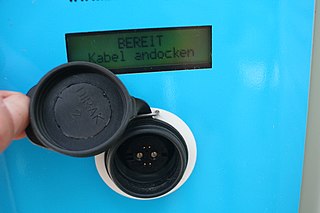 W
WBattery balancing and battery redistribution refer to techniques that improve the available capacity of a battery pack with multiple cells and increase each cell's longevity. A battery balancer or battery regulator is an electrical device in a battery pack that performs battery balancing. Balancers are often found in lithium-ion battery packs for laptop computers, electrical vehicles. etc.
 W
WA battery charger, or recharger, is a device used to put energy into a secondary cell or rechargeable battery by forcing an electric current through it.
 W
WA battery regenerator is a device that restores capacity to lead-acid batteries, extending their effective lifespan. They are also known as desulphators, reconditioners or pulse conditioning devices.
 W
WA nickel metal hydride battery is a type of rechargeable battery. The chemical reaction at the positive electrode is similar to that of the nickel–cadmium cell (NiCd), with both using nickel oxide hydroxide (NiOOH). However, the negative electrodes use a hydrogen-absorbing alloy instead of cadmium. NiMH batteries can have two to three times the capacity of NiCd batteries of the same size, with significantly higher energy density, although much less than lithium-ion batteries.
 W
WVarious methods exist for recharging the batteries of electric cars. Currently, the largest concern surrounding electric vehicle transportation is the total travel range available before the need to recharge. The longest range recorded to date was 606.2 miles, achieved by a Tesla Model 3. However, this was conducted in very controlled conditions where the car maintained a constant speed without the added drain of the air conditioning compressor. Typically, the battery would last for approximately 300 miles - the equivalent to three days of city commuting in warmer weather, or one day in colder weather. With these limitations, long-distance trips are currently unsuited for an electric car unless rapid charging stations are available on the route of the trip.
 W
WEnergyBus connectors are used for charging electric bicycles and pedelecs within Europe. The connector is circular in shape and specified for charging light electric vehicles at up to 1.5 kilowatts. Electric power is provided at 12–48 volts direct current (DC) so that any battery charger can charge any rechargeable battery.
 W
WIUoU is a DIN-designation for a lead-acid battery charging procedure that is also known as 3-stage charging, 3-phase charging, or 3-step charging. It consists of three phases, to be executed by a battery charger. The three phases are: I-phase, Uo-phase, and U-phase. The purpose is to fully charge the battery in a relatively short time without reducing its life span and to keep the battery charged indefinitely as long as the charger is connected.
 W
WA smart battery or a smart battery pack is a rechargeable battery pack with a built-in battery management system (BMS), usually designed for use in a portable computer such as a laptop. In addition to the usual positive and negative terminals, a smart battery has two or more terminals to connect to the BMS; typically the negative terminal is also used as BMS "ground". BMS interface examples are: SMBus, PMBus, EIA-232, EIA-485, and Local Interconnect Network.
 W
WA smart battery or a smart battery pack is a rechargeable battery pack with a built-in battery management system (BMS), usually designed for use in a portable computer such as a laptop. In addition to the usual positive and negative terminals, a smart battery has two or more terminals to connect to the BMS; typically the negative terminal is also used as BMS "ground". BMS interface examples are: SMBus, PMBus, EIA-232, EIA-485, and Local Interconnect Network.